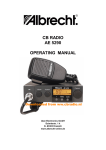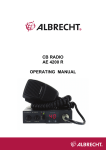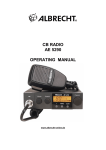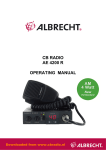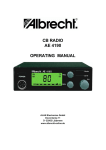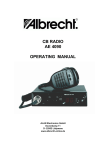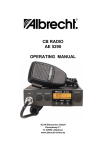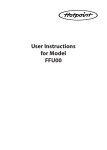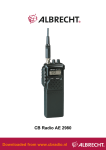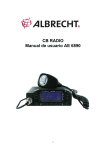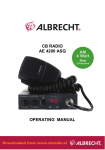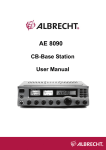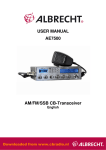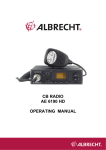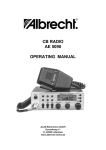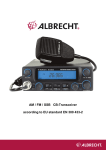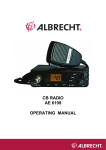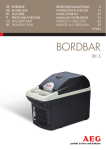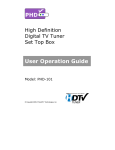Download Albrecht AE 6690 manual
Transcript
CB RADIO Operating Manual AE 6690 Index Introduction Accessories included Installation of the radio Power supply connection Replacing a fuse Antenna connection / Rear view Installation instructions of the vehicle manufacturers Legal Details CE-label Safety Precautions Radio Passport Front view / Operation Country-programming Most important functions Receiving Switching on and adjusting volume Selecting the operating channel Adjusting squelch (muting) Direct channel access Transmitting and correct use of the microphone Function of the keys Left side of the keys ASQ Automatic squelch Right side of the keys Pilot Tone, CTCSS, Tone-Squelch, TSQ AM / FM mode switch Frequency-Channel number switch, FR External sockets External loudspeaker Microphone socket Service and Warranty information Internet link addresses Technical Details Declaration Of Conformity Short manual Instrucciones breves Aide-mémoire Circulation Card Disposal of electronic waste 2 3 3 4 4 5 6 6 6 6 7 8 9 9 10 10 10 10 10 11 12 12 13 13 13 14 14 14 15 15 15 15 16 17 18 19 20 21 22 24 Introduction Congratulations to your new CB-Radio AE 6690. This CB-Radio from our Heavy Duty series is an extremely solid and robust made radio and is allowed nearly all over europe (except Austria, there you are only allowed to use a special programmed FM version), which you can programm fitting to the country in which you want to use this radio. As the european regulations, which count for some years in all EU countries, say, that you have to make yourself familiar with the using standards, we ask you urgently to read this operating manual and especially to use only the programming which belongs to your country. Your new Albrecht CB Radio AE 6690 offers you: • 40 channels FM / 4 watt, 40 channels AM / 1 watt (programming 40/40 EU) • 80 channels FM / 4 watt, 40 channels AM / 1 watt (programming 80/40 dE) • 40 channels FM / 4 watt (programming 40 FM / factory setting Austria EC) • 40 channels FM / 4 watt, 40 channels AM / 4 watt (programming for Poland Po) • 40 channels FM / 4 watt, 40 channels AM / 4 watt (programming for Spain E) • 40 channels FM / 4 watt (programming 40 FM for UK U) • Channel selection rotary control on the radio and at the microphone (Up/Down) • Big LCD Display for channel, frequency, status, Power and S-Meter, blue backlight • 6-pin standard microphone socket, suitable also for amplifier microphones, selective calling systems or Packet Radio modems / TNC’s • Socket for external loudspeaker • Switchable CTCTSS pilot tone with max. 48 possible codes • 1 programmable special channel (priority channel) with dual watch and 3 free selectable memory channels • EEPROM flash memory to save the last settings in case of power interruptions. Versions for specific countries with other features (for example Austria without multichannel AE 6690 FM) are also available. Accessories included Your AE 6690 comes operational with the following accessories: • mobile mount • detacheable DC power cable with looped-in fuse • Electret hand-held microphone with pre-amplifier and up / down buttons • microphone hanger • various screws to fasten the radio and microphone fixing devices • User manual with Radio Passport 3 Installation of the radio You can either operate your ALBRECHT AE 6690 in the car or at home as a base station. For installation as a mobile station in the car, a mobile mount device is enclosed. Mount the set in such a way that it is not exposed to direct sunlight if possible, as this would lead to an increase in the temperature and can decrease the (set’s) working life. The set should also not be installed near a heater. Mount the set in such a way that it is exposed to as little vibration as possible. The mobile fixing device should be attached to the dashboard, the tunnel slot or to any other suitable place using the enclosed tapping screws. Do not install the set in a place where it could cause injuries in the case of an accident (be careful to ensure free leg movement). Take care not to damage any underlying wires during installation! Then insert the radio into the mobile mount device. Secure the set with the large knurled screws (using the enclosed washers) firmly at the required angle. Also mount the microphone hanger using the enclosed screws in an easily-accessible place. In order to prevent interference to the vehicle electronics from transmission in the vehicle, please make sure to take any mounting instructions from the vehicle manufacturer for radios and antennas into account. Power supply Your AE 6690 receives power from the 2 pin fixed power cable. The red and black wires in the cable are for the power supply. The cable has a looped-in fuse. You can choose from two methods when connecting to the power supply (red and black): Example 1 The radio should be able to be switched on and off at any time using the volume / on/off switch. The radio shall keep the last used setting. Connect up the red to the positive pole on the vehicle battery (or elsewhere in the vehicle’s electrical system with permanent plus) or to a 12 volt power unit. Connect up the black wire to the negative pole on the vehicle battery or the power unit or to a well-conductive part of the car body. (Not all body ground positions are good for radio communication- in most cases the battery Minus is the best connecting position) Example 2 The set should be automatically be switched on and off with the ignition switch of the car. Due to it’s EEPROM memory the radio will also store the last channel and country setting used before, regardless how long it had been discontinued from power. Attach the red wire to a part of the vehicle electrical system which is interconnected to the ignition. Connect the black wire to the negative pole on the battery or the vehicle body. Note for all connecting methods: For EMC reasons, the cable used to connect to the power supply should be no longer than 3 metres. If you wish to operate your set at home from the mains supply then please only use a stabilised power supply with at least 2 amps permanent current capacity. Under no circumstances should 4 you use a car battery charger, as these are not stabilised and during open circuit reach such high voltage levels that your radio set could be destroyed. If in base station use it may be important to keep the last setting after switching off and on again, then please do not switch the external power supply power unit off when you switch your set off for a short time. Only use the on/off switch on the transceiver itself. Never repair a blown fuse with silver paper or with aluminium foil! Use only original fuses for 2-5 A max. If the fuses keep blowing, then please give your radio set to your servicing dealer to be repaired or hand it in to an authorized service station. The maximum allowed voltage variation for this radio is from 10.8 volts up to 15.6 volts. Never exceed the upper voltage limit under no circumstances! The transmitting stages for your AE 6690 are electronically stabilised, and therefore it is impossible to increase output by means of excessive supply voltage. Such attempts may lead to serious damage to the radio set but will never increase output power! Inctructions especially for truckers and motor home users: The permitted operating-voltage of the radio may vary from 10.8 to 15.6 V, so between these to values the performance data of the radio do not change. The transmitting levels of your AE 6690 are electronically stabilised. So an increasing of the performance by using an excessive operating-voltage is impossible. With such tries you only risk damaging your radio, but not an increased performance! Trucker should take care of never connecting their radio directly to 24 Volt. At 24 volt you need a suitable voltage transformer from 24 Volt to 12 Volt. As in trucks are often voltage transformers are already installed, e.g. for mobile phones, TV, car radio, you can calculate the power consumption with ca. 1,5 to 2 A. The extremely compact and low-loss transformer with a CE sign are interference suppressed for “normal” car-electricity consumers like radios, refrigerator boxes oder coffee machines, but this normally does not suffice for an undisturbed CB transmittion, as CB radios have supersensitive receivers. For a proper CB-transmittion by using transformers and in vehicles with board computers we cannot give any guarantee. Problems cannot be eliminated in all cases without trial and error. It is important, that the antenna is installed as far away as possible from other antenna and from the converter wiring and that it has a good mass area. In contrary to mobile phone- and radio antennas the normal CB antennas cannot be installed on plastic surfaces, except they have a metall foil underneath. The bonding is for CB radios very important. In case the truck has a metal mirror mount, the foot can be installed there by using an angle bracket mount, but not e.g. on a clear polyester roof oder -wind deflector. Is there no possibility to install the antenna on a conductible underground, we have special mass free CB mobile antennas like the GL 27. Use with a 230V power supply at home Use your CB radio at home only with a special CB radio power supply with stabilisation, which delivers min. 1,5 – 2 Ampere at 12 – 13,8 Volt constant voltage. A good and suitable power supply would be Article number 4744 from Albrecht. Unstabilised power supplies, charger for car batteries or the popular coolbag-power supplies are unqualified for radio and must not be used. Switchable power supplies can only be used if you use an exterior antenna far enough away from the power supply that no the noise radiation can be picked 5 up. The plus cable (red) has to be connected to the Plus (+) connection of the power supply and the black wire with the Minus (-) connection. Antenna connection Connect your CB antenna to the ANT socket on the rear side of your ALBRECHT AE 6690. Most CB antennas must be tuned to best radiation during installation to give highest effective communication range. CB specialists do that job with a standing wave (SWR) meter to check and adjust the aerial. Tune the antenna to the best standing wave ratio (SWR) on an intermediate channel e.g. using Channel 1 in 80/40 mode (26.965 MHz) or Channel 20 (27.205 MHz) in all other modes. Truckers should prefer CH 9 for optimum alignment. On this channel you should obtain a SWR of approx. 1.5 or less. If the SWR deteriorates on the highest (Channel 40) and lowest (Channel 41) channels up to a value of 2.5, then your aerial is still acceptable. SWR above 3 is too bad for good communication range. A bad SWR may also indicate that there is perhaps an installation error or missing ground. Problems may be caused through missing ground, especially in boats and motor homes with fiber glass body. For these cases, Albrecht offers a special connecting cable with matching box as “artificial ground” (AKM 27), or ground less antennas like GL 27. Some antennas, like “Gamma II” are broadbanded and do not need any retuning during installations. Even if your AE 6690 has a heavy duty transceiver with a high-level output stage which can even withstand mismatching of SWR=3, you should still never transmit without an antenna! Installation instructions of the vehicle manufacturers European directives allow the car manufacturers to decide, where, or even whether or not private radio transceivers may be operated in their cars, this is also valid for antenna installations. Please install Your mobile CB station only in accordance to car manufacturer’s installation instructions. Legal Information CE-Marking This device is provided with the from the R&TTE Directive required identification: The CE sign means, that this radio achieves the basic requirements of the new european regulations. The so-called R&TTE Directive displaced all earlier national “type approvals” in the EU and also regulates the bringing into circulation and the use of radio installations. So the ownership and the trade with proper labelled devices such as the AE 6690 in the EU and some other (not EU-) countries, who accept the R&TTE Directive, allowed, while for the use of radio 6 installations there are still different rules, depending on the programming and the country. For CB radios this means: the technical standards EN 300 135 and EN 300 433 are valid Europe-wide, but not the use of specific modulation types and channel numbers. So there still are differences in the programming of the channel numbers in AM and FM and still some countries charge license fees for CB radios. All radios, for which there are somewhere in Europe restrictions, have beside the CE sign also an “Alert Sign” sign (see last page). All manufacturers have been obliged to inform their users noticeable on the package and in the manual, what they have to follow while using the device. This is in so far understandable, because the frequencies were used for different objects in every country and so it takes a while to harmonize all those different frequencies. The AE 6690 achieves the for CB radio harmonised european radio-standards EM 300 433-2 and EN 300 135-2 as well as EN 301 489-13 for the electromagnetic compatibility and EN 60 950 for the electric safety. So this device does not transmit any harmful radio interference and is on the other side also immune to radiations from other devices, if it is used as intended. In generally this is the case, if you do not connect any cables to the microphone- and loudspeaker jack which are longer than 3 m. Our recommendation: if you use your radio with the AM-programming, please consider the licence conditions mentioned above seriously! You risk, if you are found that You have a wrong programming and you cannot show a licence, a possible penalty or other sanctions. It is also important that you register in your home country, if there still is a registration necessary. In Germany the “Bundesnetzagentur” is responsible for potential special permits in border areas. In bigger cities you find the address of the responsible outpost either in the telephone directory or you ask in the central office of the “Bundesnetzagentur”: 0049-6131-180. The Circulation Card is also released by the “Bundesnetzagentur” in Germany. Safety Instructions Users with pacemakers are recommended as a precaution to consult their doctor before operating the CB radio. Not all types of pacemakers are sufficiently protected from radiation from a nearby transmitter, so do not assume it is safe to start operation without checking! Please remember that you are in the immediate vicinity of a transmitting aerial, particularly when used as a mobile. If your doctor, or the manufacturer of the pacemaker, has recommended keeping a certain safe distance from the aerial, then please follow their instructions! Do not transmit without connecting the aerial and never touch the aerial during transmission! Please also take road safety into account! CB Radio (even when only receiving, particularly when volume is turned up) can divert your attention from the road! Road safety is of course to be given priority! Therefore only use your ALBRECHT AE 6690 when the traffic situation enables it to be used safely. 7 ALBRECHT RADIO PASSPORT AE 6690 This international version and the FM only version of this CB radio complies to the latest European regulations (R&TTE directive and European harmonised standards) and has been notified in the countries according to following table: (as of August 2007), while only the special Spanish version (4 W AM) is allowed to be used in Spain! Important Note: Please respect the licence conditions in the above listed countries and do not use the radio without licence, where necessary. For travelling with Your radio, we recommend to provide a copy of Your home country licence document and this Radio Passport together with the radio. Country Country switch position Licence and operating conditions Operation only with individual licence Austria 40 FM Belgium Italy Switzerland and Liechtenstein Spain 40/40 and 40 FM 40/40 and 40 FM 40/40 and 40 FM Austria does not accept radios with country switches, please do not use in Austria or ask Your dealer for a limited 40 CH FM version AE6690FM! Residents in Belgium need licence Licence and regular charges for all CB radios Licence and monthly charges for Residents 40/40 and 40 FM Licence and regular charges for Residents Operation without licence and charges allowed 8 Belgium 40FM 40/40 Czech Republic 80/40 switch position Denmark / Lithuania Finland 40 FM 40/40 and 40 FM France Germany 40/40 and 40 FM 80/40, 40/40, 40 FM Great Britain (UK) Greece Hungary, Cyprus Iceland Ireland Luxembourg, Malta Netherlands Norway Estonia, Latvia, Poland, Slovak Republic and Portugal Spain 40 FM UK and 40 FM Europe 40 FM 40 FM 40 FM and 40 AM 40 FM 40 FM 40/40 and 40 FM 40 FM 40 /40 and 40 FM Slovenia, Sweden Switzerland and Liechtenstein 40 FM 40 FM and 40/40 40 FM and 40/40 Free for short-time travellers up to 1 month Home country licence /Circulation Card accepted for travellers Free of licence and charges for all users, but AM channels are not allowed to be used Free of licence and charges for all users Free of licence and charges for all users (travellers with Circulation Card) Free of licence and charges for all users Free of licence and charges for all users except in some border regions for base stations using channels 41-80 Free of licence and charges for all users Free of licence and charges for all users Free of licence and charges for all users Free of licence and charges for all users Free of licence and charges for all users Free of licence and charges for all users Free of licence and charges for all users Free of licence and charges for all users Free of licence and charges for all users Free of licence and charges for travellers with Circulation Card Free of licence and charges for all users Free of licence and charges for travellers with Circulation Card Operation Receive Volume On-Off 6 pin MIC socket LCD Channel & Status Display SCH – TOT - AM/FM – Channel 9 FC – BP – TSQ - ASQ Squelch Rotary control Channel Programming the country-settings Your CB radio can always be switched between 6 different country versions. To switch you need to hold one or two buttons on the front side while you turn on the radio with the VOL/ON (volume and on-/off). Afterwards you release the pressed button(s). The programmed country code is saved as long as you programm another country code or until the device is disconnected from the power supply. The factory setting, with which your device after connecting to 12 V starts, may be differently for delivery in specific countries. When first turned on, radios sold in Germany will start with the AM/FM programming: • dE 80/40: 80 channels FM and 40 channels AM. The pre-programmed channel is channel 9 in AM, so the device starts directly on the international trucker- and emergency channel. Shortly after turning on the device “dE” is displayed. This programming is only allowed in Germany and Czech Republic and must not be used in any other country (in the Czech Republic only FM is allowed). • EU 40/40: 40 channels FM and 40 channels AM. The pre-programmed channel here is also channel 9 in AM, so the device starts directly on the international trucker- and emergency channel. Shortly after turning on the device “EU” (for Europe) is displayed. This programming is provided for Belgium, Germany, Estonia, Switzerland (with Liechtenstein), Finland, France, Ireland, Italy, Latvia, the Netherlands, Poland, Portugal, Spain and Slovakia. For Poland we also have a special programming (see further below), where the frequencies are 5 kHz displaced downwards, as it was in the old Poland standard. For Spain there is also a special programming with 4 Watt AM. This and the Poland switch position may only be used in these countries. • 9 EC 40 FM: 40 channels FM (past CEPT setting) Some countries of the European Union (Setting EC) do not allow the use of the AM band. In Denmark, Great Britain, Greece, Iceland, Luxemburg, Lithuania, Malta, Norway, Sweden, Hungary and Cyprus you should use only the EC 40 FM programming. • Po 40/40: 40 channels FM (4 Watt) and 40 channels AM (4 Watt) on the in Poland common frequencies, which are, compared to the international frequencies, displaced about 5 kHz downwards. This setting is only allowed in Poland, nowhere else!! • E 40/40: 40 channels FM (4 Watt) and 40 channels AM (4 Watt). This setting is only allowed in Spain, nowhere else!! • U 40 FM: 40 channels FM according to the United Kingdom’s frequency allocation In Austria the use of switchable CB radios is generally not allowed. If you travel through Austria, you are allowed to let your CB radio installed as it is, but you are not allowed to use it. For customers in Austria, we have a CEPT version AE 6690 FM without switchable countries on demand. Please attend the country instructions according to the pass card! You can always find the newest terms and conditions on the current pass card, which you can find on our service website www.hobbyradio.de. Change country setting • • • • Hold SC and BP and turn the device on. The channel display and country code start flashing. Now you can choose the new country setting with the channel rotary knob. Confirm with SC, the flashing stops and the setting is saved. Most important functions Receiving with AE 6690 Switching on and adjusting volume The on/off switch is combined in the VR control. To switch on: • Turn VR control from OFF position slightly right. LED display will be illuminated. Then turn further until desired volume is reached. Selecting the operating channel • with Up or Down buttons on the radio You can continuously select channels. The present channel is displayed. • Press the respective button longer to run up or down through the channels. The present channel is displayed. Adjusting squelch (muting) Particularly in FM, noise can be a nuisance on a free channel. With the muting control (SQUELCH) SQ You can suppress this noise - but also signals which are too weak to be received properly. This is how to adjust the signal strength required to switch on the loudspeaker, using the SQUELCH control knob SQ: 10 The further the control knob is turned to the right, the stronger a signal has to be in order to be audible through the loudspeaker. In order to adjust the set to be the most sensitive to incoming signals, switch to a free channel: • Use the up / down switches to find a free channel, where no signal is displayed. • Then turn the SQUELCH control SQ carefully to the right until the noise just about disappears. Now the loudspeaker stays off when on a free channel but it switches back on when receiving even very weak signals. The squelch muting adjustment is particularly important during channel scanning. In this mode the point to which the set is adjusted decides whether scanning is stopped at the signal or not. Therefore you should test the various muting settings for various signal strengths and get to know this function. AM / FM mode switch In the German channel system 80/40 You can now receive on all 80 channels in FM and AM, but you can transmit on all these channels only in FM. In AM the only channels 1-40 are enabled for transmitting. If you should try to transmit in AM on other channels, the LED will blink to warn You. Transmission on such channels is technically deactivated. The transmit mode is displayed as AM or FM in the display. Special interest channels There are a few channels which have been established for certain purposes: Channel 1 Channel 9 Call channel in FM (Germany only) Call and emergency channel, in Germany particularly this channel is also used by all truck drivers in AM. This means: a large number of stations are listening in. If the worst comes to the worst (e.g. in case of accident etc.) there is a good chance that someone will be listening. To call other stations, who you know are listening in on channel 9, you can also use this channel. Call up the desired station on channel 9. As soon as contact has been made, agree on a free channel for your conversation and then channel 9 will be free again for other calls. An emergency channel can of course only work if as many stations as possible are listening in. Therefore listen in to this channel as often as possible! Channel 16 Channel 19 Channel 24/25 Channel 40 Water sport channel Trucker channel on AM in France, Spain and Italy Data transfer (Packet Radio, Germany only) Calling channel in Switzerland Some recommendations have been worked out by the CB clubs for the new channels 41 to 80 in Germany. To find out which channels are suitable for special purposes, please get in touch with the respective groups or check in CB magazines. Direct channel access key CH 9 Your transceiver has an extra button on the front panel which provides direct access to the most important channels 9 described in previous chapter. You can toggle with the button between “normal” channel selected previously, CH 9 and back again. Just press the button consequently. 11 Scan mode Your AE 6690 has an automatic channel scan, which can be used to observe all channels consequently. First choose the mode (AM or FM). Adjust the muting control to the point at which the receiver should open (see also ‘Adjusting squelch’). Start channel scan • Briefly press the button SC • Scan starts almost immediately by scanning all the channels upwards • Scanning is stopped at each signal worth receiving and you can listen in to the conversation. If you leave the set alone it will re-start a) after the communication on the channels has stopped or b) after about 5 seconds observation time, if the communication should last longer. Stop channel scan • You can stop the scan at any time by pressing the SC button a second time. • Pressing the transmission button will also automatically stop the scan modus. Transmitting and correct use of microphone With the transmission button (Push To Talk) on the side of the microphone you can switch between receiving and transmitting: • Press PTT button to transmit. Your radio is equipped with a TX control LED, this will light when You are transmitting on an allowed channel in an allowed mode. • Release PTT button again to switch back to receiving. When the transmission PTT button is depressed, you can speak from a distance of about 5-10 cm into the microphone. After pressing the PTT button, please wait about ½ second before You start speaking. Please remember- that different from GSM phones- You share one channel common for transmit and receive, and your transmitter and the receiver(s) on the distant side need a certain time to switch on. The modulation amplifier of your AE 6690 is sensitive enough and enables you in most cases to speak with even more distance, depending on how loud your voice is. An automatic regulator ensures that your partner always hears your signal at the same volume. It is best to test the best distance from the microphone for yourself with the help of another station. Function of the keys We distinguish between primary- and secondary function of most keys: 12 • The primary function is printed directly on the key and is achieved with a short or longer push on the regarded key • The secondary function you can achieve by first pushing FC and afterwards the regarded key. The printing for the secondary functions is directly next to the keys. • The activated function will then be shown in the display. Left side SCH Special channel: short press: switch to the special channel respectively back again to the manual channel selection MCH SW Special- and normal (=manual) channel watch: first press FC, afterwards SCH This function is some kind of dual watch. The radio is switching between the last manual selected channel MCH and the special channel SCH, so you can watch both channels. The watching stops as soon as there is some noise on one channel. TOT Time-Out-Timer on/off: with switched on time-out-timer the transmitter turns of and back to receiving, if the PTT button is pressed longer than 3 minutes A/F type of modulation (AM or FM, if activated): with these key you can choose between AM and FM. The type of modulation will be displayed. The FM radios for Austria do not have any function on this key. CH9 direct dialing key: switches at the push of this button from the last selected channel directly to channel 9 and back. Channel 9 is the international call- and emergency channel: especially in Germany this means: on this channel there are many stations listening. In case of an emergency there are great chances to be heard on this channel. Also for calling other stations, from which you know they are listenting to channel 9, you can start a call there. Call the desired station. As soon as you got someone from this station, agree on another channel and move there, so that channel 9 is free again for other calls. Of course such an emergency channel only works if there are enough stations who listen. So try to listen to this channel as much as possible – this direct key helps you. With the next time pushing the CH9 key your radio switches to your last used channel. This channel is used by nearly all truckers also on AM. M1-M3 select memory channel: press FC, afterwards press M1, M2 or M3 Change memory channel: choose a channel, press FC and afterwards press M1, M2 or M3 a little bit longer. The memory channels are perfect to save often used channels. ASQ automatic squelch on/off (look at the chapter about the automatic squelch on page 11) Right side 13 FC Function key: This key switches other keys on their secondary functions. To use the secondary functions press FC and afterwards the key with the secondary function you want (printed next to the keys). SC SCAN on/off: press SC longer than 3 seconds, release. Now the scanning of all channels starts. Here all channels are scanned one after another. When the scan function recognizes a busy channel the scan stops for some seconds so that you can listen to the conversation. Important for the scan is to adjust the squelch level so the scan only stops on channels who are really busy. After about 5 seconds the scan goes on as well as when the signal is too weak and falls under the adjusted squelch level. If CTCSS is switched on, the scan only reacts on signals which use the selected CTCSS code. Stop scan: press SC longer or press the PTT button shortly. BP key sound on/off These are the short sound you hear when you press a button. RB Roger beep on/off: press SC and afterwards BP. The roger beep is a sound which you hear after ending a transmittion. It is very helpful if a radio connection gets weaker. The partner station can here the roger beep easier between all the noise and knows that the other one has stopped talking. TSQ Tone squelch (pilot tone or CTCSS) is a new function in CB radio communication. This tone squelch replaces the conventional squelch circuit, which reacts on a weaker noise or an increasing field strength. Instead there is an inaudible, very well defined deep tone between 67 and 250 Hz in every FM transmission. This tone will be interpreted by the partner station if this station also is equipped with this function. The loudspeaker will only turn on, if the device “hears” this tone. So the reception can be used to select between several stations or groups, who all use the same pilot tone. Technically, CTCSS systems can only work in FM mode and not in AM! Note: So you can build an own group with your friends for example und everybody in this group can listen to the other ones, but there will not be any external signals. With activated TSQ the normal noise blocker is not activated. So this setting is meaningless then. The radio has the ability to decode the CTCSS codes always in the best sensitivity and does not react to any noises or external signal without CTCSS. • • Theoretically there are 48 user groups on each channel possible. The first 38 tones are internationally standardised, the codes from 39 to 48 are additionally possible with other AE 6690 at the distant partner stations only. CTCSS codes are often also described as Sub Channels or Pilot Tone system. This function is also ideal for CB gateways! 14 TSQ TSQ on/off: press TSQ Changing CTCSS code: press TSQ long until the code display is flashing. After that, select with the channel knob a code between 01 and 48 and confirm with TSQ. FR With this function you can choose between the normal channel numbers displayed and the displaying of the frequency. Press FC (for the secondary function) and afterwards ASQ. AM/FM mode switch The traditional CB radio started in the USA with 23 channels and the classical AM modulation, as it was usual in HAM-radio, air radio and commercial stations in the 50’s and 60’s. Today you find AM only in middle- and shortwave and at aircraft radio. In commercial radio today you only find FM and in short-wave distance radio SSB (one-side-band-AM). In Europe the authorities intervened rather early and wanted to replace the traditional AM modulation with the (for transmitter interference) better FM modulation. But especially the truckers loved the CB traditions und are still using the amplitude modulation, while the less interfering truck diesel motors even create some advantages compared to the FM modulation: the sound was not as aggressive and a lower noise on unused channels. Meanwhile the administration reconsidered AM again as acceptable and more and more European countries allowed AM and even its enhancement SSB again, meanwhile mostly without registrations and license fees. With the function key A/F you can choose between AM and FM. (The modulation type will be shown in the display.) FM devices for Austria do not have any function on this key. In AM you can only transmit with your radio, if you have programmed the 80/40 or 40/40 mode and if you chose a channel on which AM is allowed from the transmitting side. As soon as you try to switch to a channel between 41 and 80 in AM, the radio automatically switches to the 40 channel AM mode with the channels 1 to 40 (and reverse in the german setting) Both modulation types have their own channel setting, so after a swap you always come back to your last used AM respectively FM channel. External sockets External loudspeaker Depending on the surrounding noise, it can be advisable to hook up an external loudspeaker. Usual commercial radio loudspeakers with 4-8 ohms impedance and 2-4 W minimum output can be plugged in. The cable can be up to 3 metres long. For car loudspeakers, make sure to use a two-pin 3.5 mm jack plug and ensure that none of the loudspeaker connections are attached to the vehicle chassis. Microphone socket Your AE6690 has a 6 pin microphone standard socket on the front side. To enable the additional channel selecting function UP and Down from the microphone, the socket has a special wiring at Pin No. 4 only valid for this and similar Albrecht transceivers. Apart from the hand microphone included in the package, you can also hook up other microphones, with or without preamplifier, or with or without selective calling devices. According to the latest regulations you are also allowed to plug in modems or so-called TNC`s for data transfer (Packet Radio). However, other type of microphones must be specially soldered to the 6 pin connector and do not allow additional switches. Such other microphones must not use PIN 4 of the plug. Please note that data transfer is only permitted on certain channels and only for non-commercial use and not in all countries. Service and Warranty information Troubleshooting Check at first the power supply and the fuse. A problem may be caused through power supply, when the LCD is not on after switching the radio on. If the unit works in a strange way, disconnect the power supply cable (or take out the fuse from the holder), while the radio remains switched on, wait some time (minimum 10 seconds), and then reconnect power cord again. Check the microphone and antenna connector. We think you cannot do more in case of a problem. Please ask your dealer or consult our service hints in the Internet. If You should return the radio to your dealer for repair, do not forget to describe the problem as exactly as possible. 15 European warranty regulations The distributor, dealer or retail shop where You bought the radio warrants to the original retail purchaser of this product that should this product or any part of it, under normal use and conditions, be proven defective in material or workmanship within 2 years from the date of original purchase, such defect(s) will be repaired or replaced with new or reconditioned product without charge for parts and repair labor. To obtain repair or replacement within the terms of this warranty, the product is to be delivered with proof of warranty coverage (e.g. a copy of Your bill of sale), specification of defect(s), to the distributor, dealer or his authorised repair centre. Liability for communications range of this product is disclaimed. The warranty does not apply to any product or part there of which, has suffered or been damaged through alteration, improper installation, mishandling, misuse, neglect, accident, or by removal or defacement of the factory serial number label(s). The warranty does not apply to accessory parts or problems caused through not authorised or not recommended accessories like other than the supplied microphone, external antennas, external power supplies and over voltage caused through external power supplies, lightning or over voltage defects via antenna or other cables, broken or damaged acrylic glass windows and cabinet parts. Furthermore we afford you 3 years manufacturer’s warranty for the AE 6690. Exempt from this warranty are transmitting power amplifiers and illumination resources. Our General Terms and Conditions are imperative. In any case of technical problems please contact the dealer or person where You have purchased Your CB radio. Where to find service hints and service documentation The complete technical documentation is updated regularly. You can download the latest versions of user manuals, technical documents and conformity declaration, as well as service hints or FAQ’s any time from our server under http://www.hobbyradio.de If you should have a problem, please have a look to the service hints or frequently asked questions (FAQ) before You send Your CB radio back to the service centre. Please note that the acceptance of AM+FM in the different European countries has just started and may be subject to unpredictable changes. Our homepage will provide the latest information about using the radio. 16 Technical Details Microphone socket wiring For Packet Radio & others Pin 1 Pin 2 Pin 3 Pin 4 Pin 5 Pin 6 Pin 1 Pin 2 Pin 3 Pin 4 Pin 5 Pin 6 Mic audio PTT-RX (on ground for receiving) PTT-TX (on ground for transmit) up/down key Ground + voltage for mic-power supply if needed Transmit audio Receive audio PTT key Do not connect! Ground Do not connect! Transmitter Transmitting power Modulation sensitivity Harmonic and spurious radiations Max. frequency deviation AM modulation degree CTCSS tone codes 4 Watt FM 1 Watt AM / 4 Watt AM (in Poland, Spain) appr. 3 mV at >1 kOhm -90 dBc = 4 nW less than 2.0 kHz 90% +/- 300-500 Hz deviation in FM only Receiver Sensitivity (FM) (SINAD) Sensitivity (AM) (SINAD) Adjacent channel selection Intermodulation rejection Image rejection Audio output power 17 better + 3db V EMK for 20 dB better + 3db V EMK for 12 dB better 60 dB (EN 300 135-1) better 48 dB (EN 300 433-1) better 54 dB (EN 300 135-1) better 48 dB (EN 300 433-1) better 48 dB (EN 300 433-1) ca. 2 Watt to 8 Ohm load Declaration of Conformity / Konformitätserklärung We hereby declare that our product: / Wir erklären hiermit, dass unser Produkt CB-Radio Albrecht AE 6690 satisfies all technical regulations applicable to the product within the scope of EU Council Directives, European Standards and national frequency applications:/ alle technischen Anforderungen im Geltungsbereich der EU Richtlinien, europäischer Normen und nationaler Frequenzanwendungen einhält: 73/23/EEC, 89/336/EEC and 99/5/EC EN 300 135 -2 / EN 300 433-2 EN 301 489-1, EN 301 489-13, EN 60 950 All essential radio test suites have been carried out. / Alle für das Produkt vorgeschriebenen Funktestreihen wurden durchgeführt. Alan Electronics GmbH Daimlerstr. 1 k D- 63303 Dreieich This declaration is issued under our sole responsibility. Basing on not harmonised frequency applications, the CB radio may be used only in listed countries according to selected channel programming. An individual licence for operating this radio in AM + FM on 40/40 in B, CH, E and I is requested. In D, where 80/12, 80/40, 40/12 or 40/40 FM/AM channels are allowed, CZ (only 80 FM), EST, F, FIN, IRL, LV, NL, PL, P and SK the operation on 40 / 40 channels in AM and FM is free of licence and free of charges. If the radio is programmed to 40 FM only, it may be used without license and free of charge in all EU member states + N, IS, but not in Austria, where radios with country switches are generally not allowed to be used, and Italy, where individual license is requested. Residents of Belgium, Spain, Switzerland and Great Britain (UK) need a CB license in their home country, while travellers from other European countries may use 40 CH FM during travelling in these countries free of license and charges. In Belgium 40 Channels AM is allowed for travellers under the conditions of their home country. Diese Erklärung wird unter unserer alleinigen Verantwortung abgegeben. Dieses Funkgerät darf wegen der nicht harmonisierten Frequenzanwendungen in AM + FM in den Ländern B, CH , E und I nur mit gültiger CB Funkgenehmigung benutzt werden. In D (80 FM, max 40 AM), CZ (nur 80 FM), EST, F, FIN, IRL, LV, NL, P und SK (40/40) ist der CB Funk anmelde- und gebührenfrei. Dabei ist In Deutschland ist mit der Programmierung 80/40 der ortsfeste Sendebetrieb auf den Kanälen 41 - 80 in bestimmten Regionen entlang der Grenzen der Bundesrepublik Deutschland (außer zu CZ) nicht oder nur mit Sondergenehmigung gestattet, in Tschechien darf nur FM (80 Kanäle) benutzt werden. Mit der Programmierung 40 FM darf dieses Gerät in allen EU Mitgliedsstaaten + Island, Norwegen (außer Österreich, dort ist der Betrieb von CB Funkgeräten mit Länderumschaltung generell nicht erlaubt) und Italien (dort ist auch der CB Funk mit 40 Kanälen FM genehmigungspflichtig), anmelde- und gebührenfrei betrieben werden. Bewohner von Belgien, Großbritannien, der Schweiz. Liechtenstein und Spanien benötigen in ihrem Heimatland eine Genehmigung (CB-Lizenz). Die vorübergehende Benutzung von 40 Kanälen FM durch Reisende aus anderen europäischen Ländern ist jedoch in diesen Ländern anmelde- und gebührenfrei erlaubt. 40 AM ist in Belgien für Reisende erlaubt, wenn die Heimatbedingungen dies gestatten (z.B. für Reisende aus Deutschland). Mitführen der Circulation Card für Reisende aus Deutschland ist notwendig in Spanien, Finnland, der Schweiz und Liechtenstein. Alan Electronics GmbH declare, bajo su responsabilidat, que este aparato cumple con lo dispuesto en la Directiva 99/05/CE, del Parlamento Europeo y del Consejo de 9 de marzo de 1999, transpuesta a la legislacion espanola mediante el Real Decreto 1890/2000, de 20 de noviembre. Point of contact/Ansprechpartner: Dipl.-Phys. Wolfgang Schnorrenberg Place and date of issue: Lütjensee, 06. 07. 2007 (Signature) Dipl.-Phys. Wolfgang Schnorrenberg Alan Electronics GmbH 18 Disposal and Recycling of Electronics Waste This CB radio has been produced according to the European RoHS directive and does no more contain certain banned hazardous substances. Please dispose defective and no more usable electronic items only via officially allowed collecting points. The new European WEEE directive does no more allow to dispose items via household trash. Please contribute to the efficient recycling of used electronic items! Alan Electronics GmbH – Daimlerstr. 1 k – D-63303 Dreieich/ Germany Spare parts and Repair Service: (+49) 6103-9481-22 Service-Fax: (+49) 6103-9481-60 Homepage: www.albrecht-online.de, www.alan-electronics.de e-mail: [email protected] Service-Download: www.hobbyradio.de © Alan Electronics GmbH, August 2007 24




















